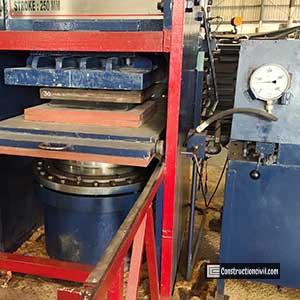Elastomeric bearing is a bridge component that not only provides a resting surface between bridge pier caps/Abutment caps and the superstructure but also helps transfer the superstructure load through the substructure to the foundation by allowing controlled movement and thereby reducing the stresses involved. A common form of advanced bridge bearing is elastomeric bridge bearing. Different types of bridge bearings are used nowadays depending on factors, including geographic location, bridge span length, span arrangements, structural seismic performance, conditions, and performance specifications.
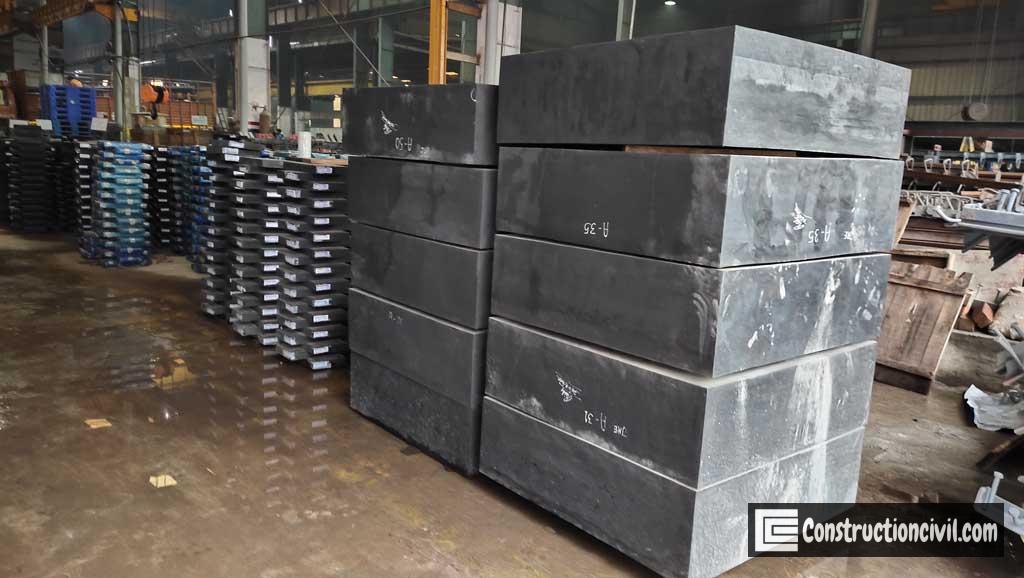
Also, Read: Types of Bridges Based on Span, Materials, Structural Arrangement etc.
Elastomeric Bridge Bearing Material:
The elastomer used during the manufacturing of Elastomeric bridge Bearing should be either natural or synthetic rubber(Chloroprene Rubber), which has excellent physical properties and can also retain properties at lower temperatures.
- Blending another polymer with up to 5% of primary rubber can be allowed to aid processing. Any reclaimed or ground vulcanized rubber shall be permitted.
- With low crystallization rates and good shelf life, Chloroprene Rubber(CR) should be used to make CR compounds for elastomeric bearing bridges.
- In the case of natural rubber(NR) compound, the grade of raw elastomer used should be RSS 1X conforming to IS: 15361.
- Sometimes, NR compound bearings shall be protected by CR compound cover layers, which means NR compounds in internal layers of bearing and CR compounds in cover layers, and both parts are vulcanized simultaneously.
- Elastomeric bearings for bridges contain at least 50% polymer and ash content not exceeding 5%.
- EPDM or similar elastomer should not be used to manufacture elastomeric bearings for bridges.
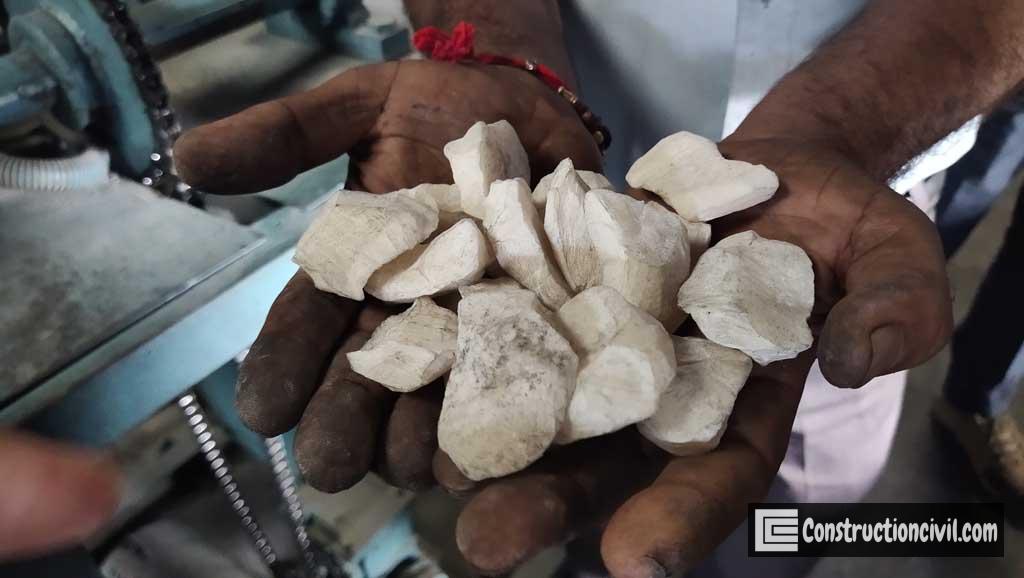
Also, Read: Types of Deep Foundation in Civil Engineering
Properties of Elastomer:
The physical properties of elastomer for standard elastomeric bridge bearing as per IRC:83, 2018 shall conform to the following table.
| SL No | Characteristics | Requirements |
| 1 | G Modulus (MPa) | 0.9 |
| 2 | Tensile Strength (MPa) for Moulded Test Piece | ≥ 16 |
| 3 | Tensile Strength (MPa) for Test Piece from Bearing | ≥ 14 |
| 4 | Minimum Elongation at Break (%) for Moulded Test Piece | 425 |
| 5 | Minimum Elongation at Break (%) for Test Piece from Bearing | 375 |
| 6 | Minimum Tear Resistance (kN/m) for CR | ≥ 10 |
| 7 | Minimum Tear Resistance (kN/m) for NR | ≥ 8 |
| 8 | Compression Set (%) 24h ; 70 °C for CR | ≤ 15 |
| 9 | Compression Set (%) 24h ; 70 °C for NR | ≤ 30 |
| 10 | Hardness | 60 ± 5 |
| 11 | Ozone Resistance | No cracks |
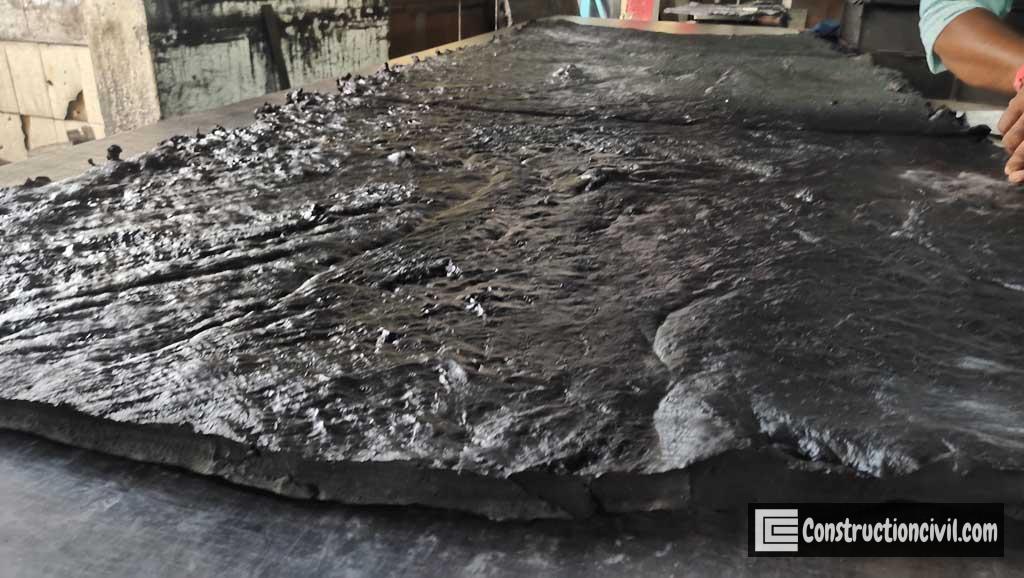
Also, Read: Construction of pile foundation by Rotary Method
Elastomeric Bearing Design Aspects:
The design of elastomeric bridge bearings deals with the equilibrium between having sufficient stiffness that can withstand the imposed vertical loads and enough flexibility to allow for the expected deformations.
- Elastomeric bridge bearings shall be designed as per the Ultimate Limit State method. At the ultimate limit state, the strength and stability of elastomeric bearings shall be sufficient to resist the ultimate design load and movements of the structure.
- Elastomers stiffen at low temperatures; therefore, choosing a suitable compound is necessary considering the environmental conditions at the bridge location.
- Typical bridge bearings are either plain neoprene pads or reinforced with horizontal steel laminates. The stiffness and flexibility of elastomeric bridge bearings are well maintained using steel plates and rubber.
- The reinforcing steel plates are bonded with rubber, which helps to restrict the bulging of the elastomeric bridge bearing.
- The reinforcement increases the compressive and rotational stiffness and controls the vertical deflection and rotation of the elastomeric bridge bearing.
- The grade of reinforcing mild steel laminates should be as per IS: 2062 or IS: 1079, and the yield stress of the laminates not less than 250Mpa.
- The shearing deformation of the neoprene pads allows the horizontal movement of elastomeric bridge bearing.
Also, Read: Construction of Pile Foundation by Direct Mud Circulation Method – DMC Pile
Elastomeric Bearing Size:
The elastomeric bearing can be rectangular, square or circular in shape. The actual elastomeric bearing size shall be decided by the manufacturer, compatible with the manufacturing facility and fulfilling all the design requirements.
- As per the bearing design, the internal elastomer layer thickness varies between 8-20mm for laminated bearing.
- Usage of internal layer thickness up to 25mm is acceptable under particular situations.
- The minimum thickness of inner reinforcing steel plates shall be 3mm (As per IRC: 83, Clause 5.1.3.5).
- The typical standard size of elastomeric bearings of type B and laminated Bearings as per R’20 series should be as per IRC:83-2018, Annexure B.
- For laminated elastomeric bearings, it is permissible to reduce the loaded area, without changing the plan dimensions, by providing holes of uniform sections in the loaded area.
- The minimum thickness of the top and bottom elastomer cover layer should be 2.5mm, and the minimum thickness of the side cover shall be 4.0mm.
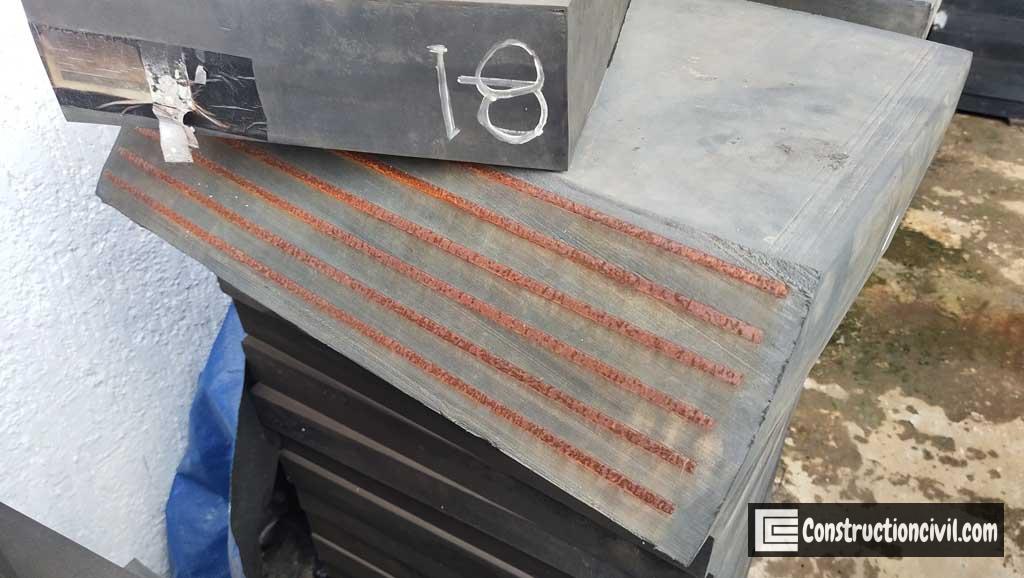
Also, Read: Construction of Well Foundation – Step by Step Procedure
Types of Elastomeric Bearings:
- Type A: Plain pad/Strip bearings
- Type B: Laminated bearings
- Type C: Laminated bearings with thicker end laminates
- Type D: Laminated bearings with thicker end laminates exposed
- Type E: Bearings with separate steel plate directly vulcanized with the bearing
- Type F: Bearings with positive anchorage
- Type G: Bearings with PTFE bonded to the elastomer
- Type H: Bearings with sliding interface
- Type I: Bearings with restraint against translation to simulate support condition
Elastomeric Bearing Manufacturing Tolerances:
During the production of elastomeric bearing for bridges, it is necessary to maintain the thickness of individual layers of elastomer, dimension of laminates, and flatness of laminates properly for quality control, and we should remember the acceptance criteria, which are as follows.
Also, Read: Rusting of Iron Rebar in Concrete – Special Repairing
Elastomeric Bearing Manufacturing Tolerances as per IRC:83-2018 (Part-II):
| SL No | Items | Tolerances |
| 1 | Overall Linear Plan Dimensions | −2 mm,+4 mm |
| 2 | Total Mean Bearing Thickness(Thickness of Bearing ≤ 100mm) | ± 2mm |
| 3 | Total Mean Bearing Thickness(100mm < Thickness of Bearing ≤ 150mm) | ± 3mm |
| 4 | Total Mean Bearing Thickness(150mm < Thickness of Bearing) | ± 4mm |
| 5 | Parallelism Of the top surface of bearing with respect to the bottom surface as the datum | 1 in 300 |
| 6 | Parallelism Of one side surface with respect to the other as datum | 1 in 100 |
| 7 | Inner layer of elastomer(5mm ≤ Individual elastomer layer thickness < 10mm) | ± 15% |
| 8 | Inner layer of elastomer(10mm ≤ Individual elastomer layer thickness < 15mm) | ± 12% |
| 9 | Inner layer of elastomer(15mm ≤ Individual elastomer layer thickness < 25mm) | ± 10% |
| 10 | Outer layer of elastomer | 0 mm,+2 mm |
| 11 | Side cover | 0 mm,+3 mm |
| 12 | Plan dimensions of laminates | +2 mm,+1mm |
| 13 | Thickness of laminate(Steel plate thickness ≤ 4mm) | +0.8mm,−0.4mm |
| 14 | Thickness of laminate(Steel plate thickness > 4mm) | +1.1mm,−0.4mm |
| 15 | Parallelism of laminate with respect to bearing base as datum | 1 in 100 |
| 16 | Flatness(Thickness of Bearing ≤ 50mm) | ± 1mm or ±0.3% of the diagonal/diameter, whichever is greater |
| 17 | Flatness(50mm < Thickness of Bearing ≤100mm) | ± 1.5mm or ±0.3% of the diagonal/diameter, whichever is greater |
| 18 | Flatness(100mm < Thickness of Bearing ≤150mm) | ± 2mm or ±0.3% of the diagonal/diameter, whichever is greater |
| 19 | Flatness(150mm < Thickness of Bearing ) | ± 2.5mm or ±0.3% of the diagonal/diameter, whichever is greater diagonal or diameter) |
| 20 | Steel laminate | 1% of diameter or diagonal (max of 1.5 mm) |
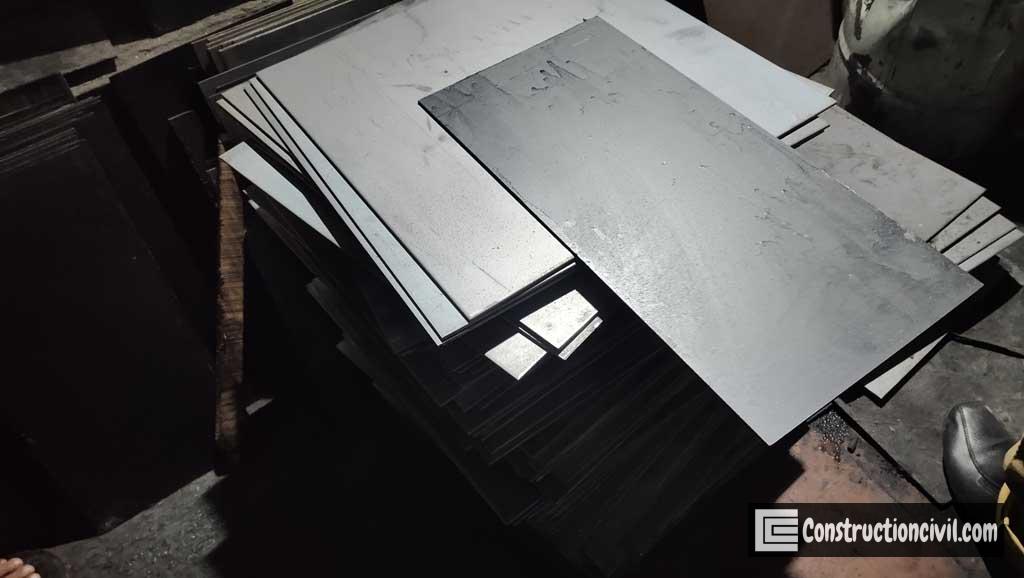
Also, Read: What is Well Foundation? – Types & Components of Well Foundation
Elastomeric Bridge Bearing Testing and quality control:
Test on Specially Moulded Test Pieces:
The manufacturer shall mould a test piece with identical CR compounds and under similar vulcanizing conditions as used in manufacturing the bearings.
The properties of the test piece to be tested are listed below.
- Composition
- Tensile Strength
- Elongation at Break
- Tear Resistance
- Compression Set
- Accelerated Ageing
- Ozone Resistance
- Adhesion Strength
- Specific gravity: ± 0.2
- Ash content: ± 0.5%
- Hardness
Test on Elastomeric bridge bearing:
General inspection:
After the bearing production, it is necessary to inspect all the bearings visually to see if there are any manufacturing defects. Following are the general inspection checks.
- Are there any issues with surface finish, shape, hardness, or superficial defects?
- All dimensions should be under the tolerance limit.
- Parallelism of bearing surfaces and flatness of load-bearing surfaces should be checked.
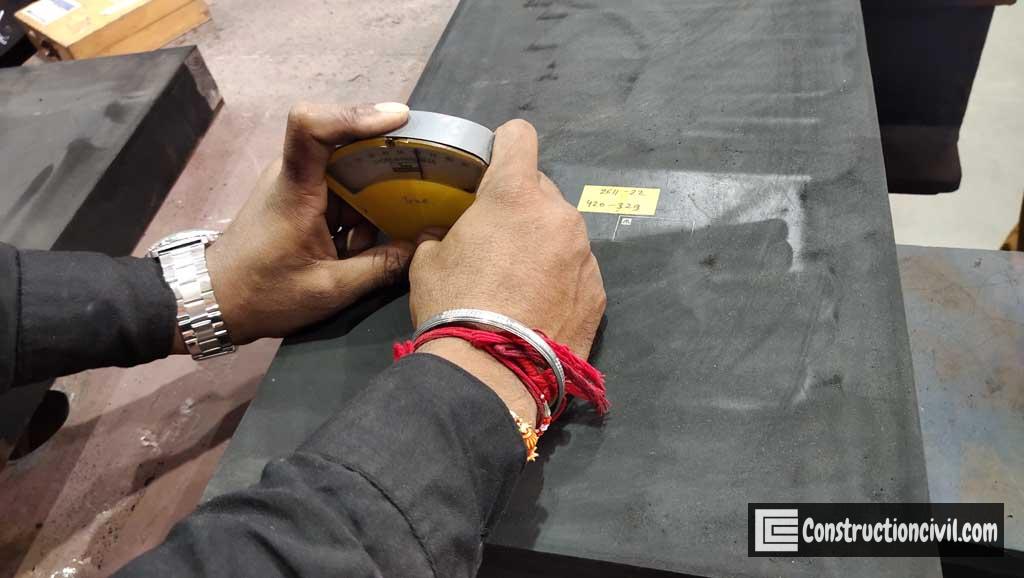
Also, Read: Causes, Prevention and Repair of Concrete Surface Defects
Axial Load Test:
Elastomeric bridge bearing shall be subjected to an axial load to correspond to the design load at the serviceability limit state while the visual inspection is made to check for discernible defects like
- Misalignment of reinforcing laminate plates
- Poor bond at reinforcing laminate/steel interface
- Thickness variation in an elastomer layer
- Any surface defects developed during axial load testing
Determination of shear Modulus on a pair of bearing:
Shear modulus represents the main material property related to the load-bearing capacity of elastomeric bridge bearings. Laminated elastomeric bearings have low shear stiffness but are stiff under compression due to steel reinforcing plates.
- Testing procedure for determining shear modulus of elastomeric bearings consists of two bearings subjected to a combination of compressive and cyclic shear loading.
Determination of compression stiffness:
Compressive stiffness is the most important parameter in the design of elastomeric bearings for bridges.
- Changes in the behaviour of multilayered elastomeric bearings under compressive load should be important for their design.
- Under specified short-term axial loading, the value of apparent compression stiffness is obtained.
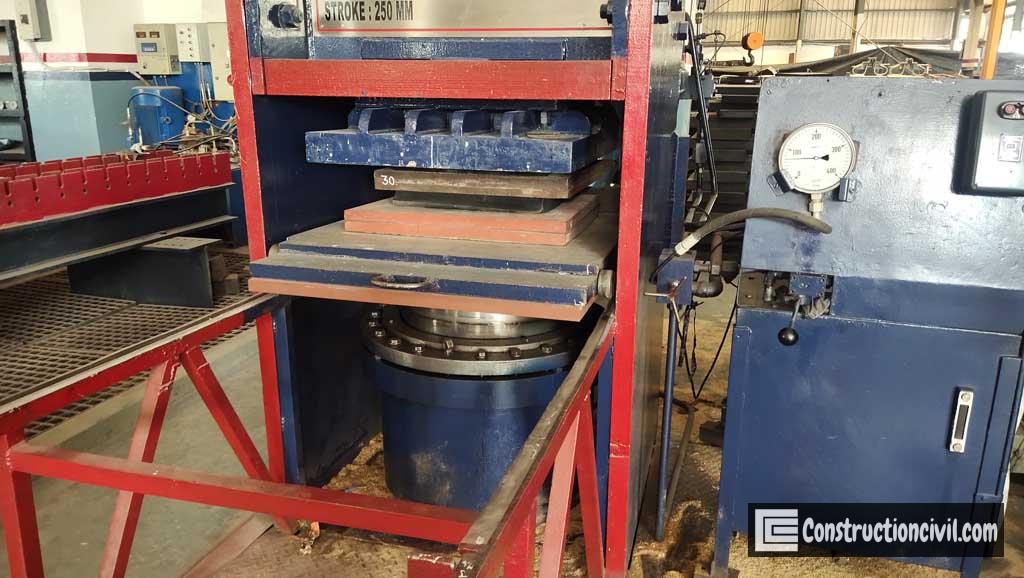
Also, Read: Maintenance of Bridges – General Planning & procedure
Determination of shear Bond:
Two identical bearings are selected randomly from the lot as test bearings to determine the shear Bond. It is a destructive test, so prototype bearings should be produced in similar conditions.
- Testing procedure for determining shear Bond of elastomeric bearings consists of two bearings subjected to a combination of compressive and cyclic shear loading.
- The primary objective of the above test is to determine whether requisite adhesion exists between the elastomer and steel laminate or not.
Advantages of Elastomeric Bearing:
- Elastomeric bridge bearings are normally designed to serve the bridge’s required life span because replacing the bearing is very hectic. Because of the above, several material tests are frequently required in design specifications to ensure good resistance to deterioration.
- Despite constant exposure to extreme climate conditions and chemical effects, such as deicing salts, elastomeric bridge bearing has served for many years with no significant deterioration.
- Bridge engineers almost universally agree that elastomeric bearings offer a longer service life with less maintenance than other types of bearings.
- Compared to other types of bridge bearings, replacing elastomeric bearings is easy, and the maintenance costs are also less.
Limitations of Elastomeric Bridge Bearing:
- Elastomeric bridge bearings are not suitable when large vertical loads are accompanied by large horizontal movement but little rotation.
- Laminated elastomeric bearing in bridges exhibits more vertical deflection than Pot-PTFE bearings.
- Laminated elastomeric bridge bearing exhibits varying degrees of vertical deflection from bearing to bearing.
